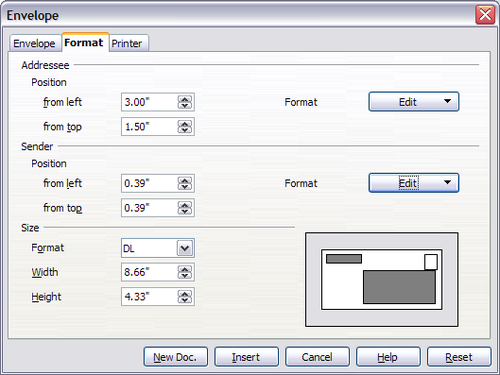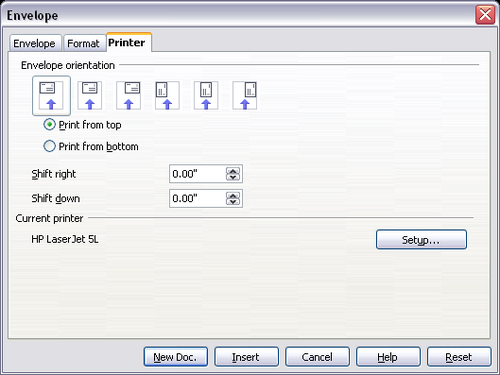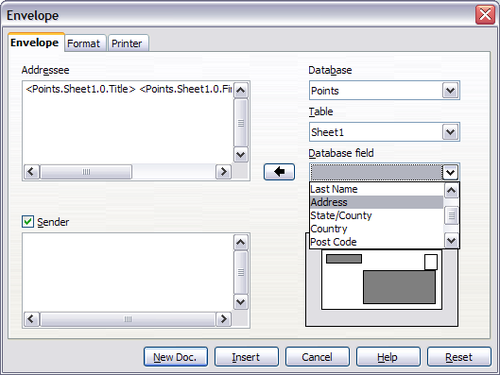Impression d'enveloppes
Au lieu d'imprimer des étiquettes de mailing, vous pouvez préférer imprimer les enveloppes directement. Il a deux façons classiques de créer des enveloppes, une où l'enveloppe est attachée à une lettre, généralement comme première page (Insérer dans la boîte de dialogue d'envelopppe) et une autre où l'enveloppe est indépendante du document (Nouveau document dans la boîte de dialogue). Dans chaque cas, les données d'adrese peuvent être saisies manuellement, par exemple, en copiant et collant à partir de la lettre à laquelle elle est attachée, ou à partir d'une source de données d'adresses.
Cette section décrit l'utilisation d'une source de données d'adresse et pour plus de facilité, une enveloppe indépendante.
La production d'enveloppes engage deux étapes, le paramétrage et l'impression, comme décrit dans cette section.
Paramétrer les enveloppes pour l'impression
Pour définir les enveloppes afin qu'elles soient imprimées avec les lettres :
- Cliquez sur Insertion > Enveloppe à partir de la barre de menu.
- Dans la boîte de dialogue Enveloppe, sélectionnez l'onglet Format (montré ci-dessous), dans lequel vous pouvez sélectionner le format d'enveloppe à utiliser. Vous pouvez organiser la mise en page de l'envelopper ainsi que les attributs de caractère et de paragraphe à utiliser dans la zone d'adresse de l'expéditeur. Ces attributs sont accessible en utilisation le bouton Éditer à la droite de la boîte de dialogue, près du mot Format. Template:Documentation/Tip
- L'étape suivant est de sélectionner l'onglet Imprimer, à partir de là, vous choisirez l'imprimante que vous souhaitez utiliser, ses paramètres, par exemple, le bac contenant les enveloppes, et d'autres options relatives à l'orientation de l'enveloppe. Vous aurez sans doute besoin de faire quelques essais pour parvenir au meilleur résultat par rapport à votre imprimante.
- Vous avez maintenant le choix de créer les champs du destinataire en glissant et déposant les en-têtes de champs de la source de données (comme décrit Création d'une lettre type, ou en utilisant les possibilité de l'onglet Enveloppe. Si vous préférez utiliser le glisser et déposer, cliquez sur Nouveau document, glissez les en-têtes de source de donnée dans la zone du destinataire de la nouvelle adresse et sautez l'étape 7), sinon continuez les étapes 5 et 7.
- Select the Envelope tab. Verify, add, or edit the information in the Addressee and Sender boxes (Sender is the “from” on the envelope). You can use the right-hand dropdown lists to select the database and table from which you can access the Addressee information, in a similar fashion to that described for Printing mailing labels, paragraphs 3, 4 and 5. The similarity of the method with the figures in that section will be clear.
- When you have finished formatting, click either the New Doc. or Insert button to finish. As might be expected, New Doc creates only the envelope template in a new document, whereas Insert inserts the envelope into your current document as page 1. If you don’t want to proceed with this envelope, click Cancel or press the Esc key. You can also click Reset to remove your changes and return to the original settings when the dialog box opened.
- Quite often some of the fields in your address data source will be unused, leading to blank lines in your envelope Addressee area. If this is not important, you can skip the next few paragraphs and go straight to Merging and printing the envelopes, otherwise continue as described here. Template:Documentation/Tip
- First ensure that the envelope is showing the field contents (data source headings), rather than their underlying field names. If this is not the case, then either press Ctrl+F9 or select View > Field Names to toggle the view.
- Next, ensure that you can see non‑printing characters, such as paragraph marks, line breaks and so on. If these are not already visible, select View > Nonprinting Characters from the menu bar, or press Ctrl+F10, or click on the large paragraph icon
 in the Standard toolbar.
You will now see that address field separation is created by line breaks
in the Standard toolbar.
You will now see that address field separation is created by line breaks - Click at the end of the first data source address field. Press Delete to remove the new line and then press Return (or the Enter key) to insert a paragraph. Repeat this action for each data source address field. If the line spacing in the Addressee area is not satisfactory, you may wish to correct this before proceeding, by modifying the paragraph style associated with the address. Unless you have changed it, the address uses the Default style.
- Click again at the end of the first paragraph to be suppressed and then select Insert > Fields > Other. Select the Functions tab and then click on Hidden Paragraph in the Type column. Now click in the Condition box and enter the details of the condition that defines a blank address field. It has the general form of: ![Database.Table.Database field] where the ‘!’ (NOT) character indicates the negative case and the square brackets delineate the condition. For example, in our Points database the condition to test if the Last Name field is empty would be: ![Points.Sheet1.Last Name]. To test for multiple conditions, use the operators AND and/or OR between the conditional statements, for example: ![Points.Sheet1.Title]AND![Points.Sheet1.Last Name]. Click Insert, but do not close the dialog until all lines have been amended.
- Repeat for each paragraph to be conditionally suppressed, remembering to advance the cursor to the end of the line in question before changing the last element of the condition and Inserting the result.
Merging and printing the envelopes
To merge addresses and print the envelopes:
- Choose File > Print. A message box appears. Click Yes.
- The Mail Merge dialog appears. As with form letters and mailing labels, you can choose to print envelopes for one, several or all address records in the database.
- Make your selections and then click OK to print direct to the printer. If you wish to check the envelopes before printing them, see Step 9) of Creating a form letter for instructions.
| Content on this page is licensed under the Creative Common Attribution 3.0 license (CC-BY). |


